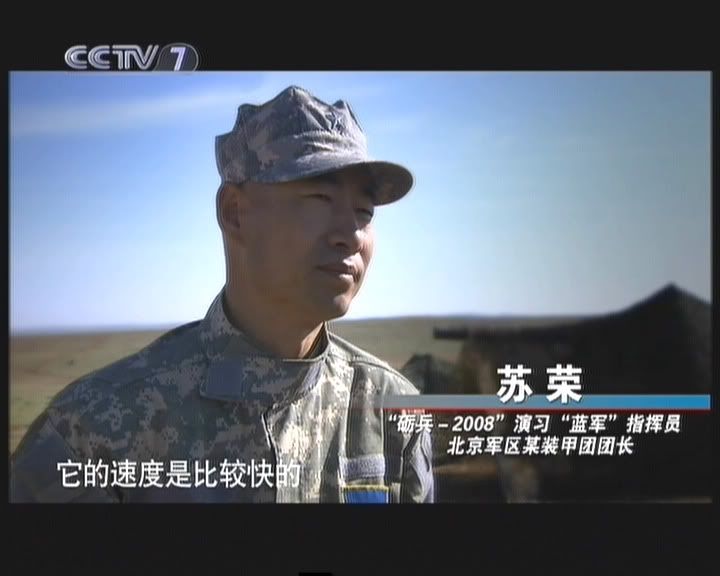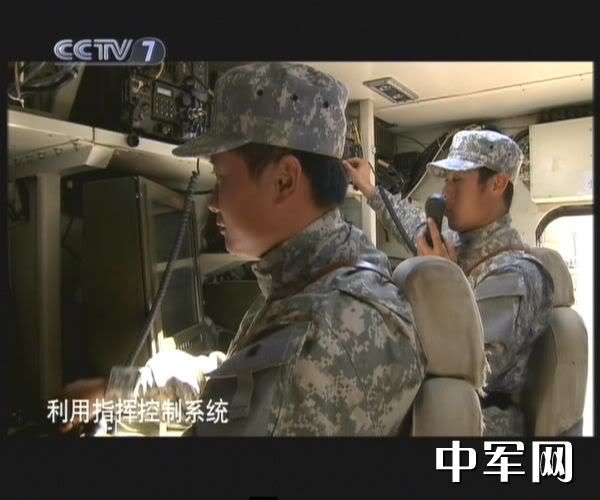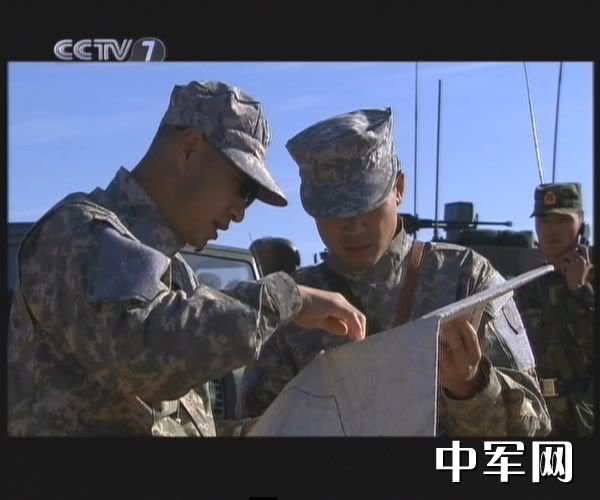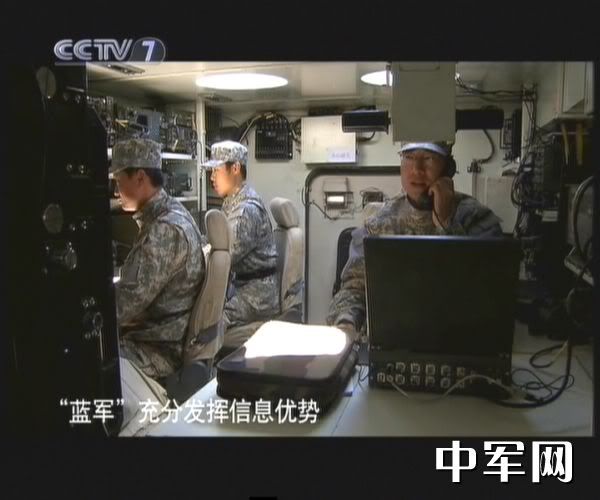So, what do I get for Christmas?
Why, a major hit piece on the People's Liberation Army/Navy/Air Force by the Washington Compost, assisted by the Russians!
Wrong. The Chinese are producing J-11B FLANKERS with the locally produced WS-10A Taihang turbofan, replacing the Russian AL-31.Military strength eludes China, which looks overseas for arms
By John Pomfret
Washington Post Staff Writer
Saturday, December 25, 2010; 12:00 AM
MOSCOW - The Moscow Machine-Building Enterprise Salyut on the east side of town has put up a massive Soviet-style poster advertising its need for skilled workers. The New Year's party at the Chernyshev plant in a northwest suburb featured ballet dancers twirling on the stage of its Soviet-era Palace of Culture.
The reason for the economic and seasonal cheer is that these factories produce fighter-jet engines for a wealthy and voracious customer: China. After years of trying, Chinese engineers still can't make a reliable engine for a military plane.
Please note the source of all these claims -- Russian news reports and weapons companies.The country's demands for weapons systems go much further. Chinese officials last month told Russian Defense Minister Anatoly E. Serdyukov that they may resume buying major Russian weapons systems after a several-year break. On their wish list are the Su-35 fighter, for a planned Chinese aircraft carrier; IL-476 military transport planes; IL-478 air refueling tankers and the S-400 air defense system, according to Russian news reports and weapons experts.
Why should the Chinese import Su-35s?
They've been cranking out J-11Bs with majority Chinese avonics and engines, along with J-10As and J-10Bs from Chengdu for the light strike/fighter role.
Also, the J-20 prototype may have taxiied -- there goes the rationale for PAK-FA on the world export market.
Additionally, the J-15 Flying Shark is coming along quite well -- so why do they need to buy Russian to get something that can fly off the Crapyrag?
Il-476 transports and Il-478 tankers? Why? The Russians had severe production problems just fulfilling the Chinese order for 30 Il-76 transports and 4 Il-78 tankers several years ago.
So why would the Chinese go to them again, when they are about to produce indigenously a large airliner -- the C-919, which can then be given a refuelling boom to fill the tanker role?
Really, the only hole so far is the lack of a heavy tactical airlifter; but that can be pushed off until the 2015s or so, since China is not going to be sending a whole Airborne Corps to invade Sudan any time soon; so the Y-9 turboprop can fill their needs (credible threat to Chinese Tapei) for the next decade.
Why do they need to import S-400s? They already have the HQ-9 rolling off like hotcakes, and being tested in the ABM role...


Left unsaid is the fact that the Chinese are indigenously building a blue water navy that is increasingly sophisticated -- Type 052C DDGs with phased arrays and HQ-N-9 SAMs -- they're not up to the level of AEGIS yet, but they are a massive jump in quality over previous Chinese Naval SAMs, which were Crotales.This persistent dependence on Russian arms suppliers demonstrates a central truth about the Chinese military: The bluster about the emergence of a superpower is undermined by national defense industries that can't produce what China needs.
They've also begun to build a nice series of LPDs, the Type 071, capable of carrying a battalion of troops, and 15-20 amphibious tanks.
Remind me again, which country is buying an amphibious warfare ship from France?
Right, Russia.
Rumor is that the Crapyrag will finally launch or whatever around June 2011, and that the PLA(N) will have an indigenous CV in the water by 2015. So in about ten years, the PLA(N) will be a much more credible force.Although the United States is making changes in response to China's growing military power, experts and officials believe it will be years, if not decades, before China will be able to produce a much-feared ballistic missile capable of striking a warship or overcome weaknesses that keep it from projecting power far from its shores.
Again with using Russians as sources."They've made remarkable progress in the development of their arms industry, but this progress shouldn't be overstated," said Vasily Kashin, a Beijing-based expert on China's defense industry. "They have a long tradition of overestimating their capabilities."
In 2000, the Chinese Marine Corps basically used modified BMP-1s with outboard motors attached along with flotation pontoons for their amphibious landing duties.
Now?
They have the ZBD-2000 Amphibious family of both light support tanks and IFVs

Haw. So the Shenyang WS-10A powering the J-11B, and later models of the J-10 doesn't exist? Shows the quality of reporting these days.Ruslan Pukhov, the director of the Center for Analysis of Strategic Technologies and an adviser to Russia's ministry of defense, predicted that China would need a decade to perfect a jet engine, among other key weapons technologies. "China is still dependent on us and will stay that way for some time to come," he said.
Indeed, China has ordered scores of engines from the Salyut and Chernyshev factories for three of its new fighters - the J11B, a Chinese knock-off of the Russian Su-27; the J10, which China is believed to have developed with Israeli help; and the FC1, which China modeled on an aborted Soviet design. It also told Russia that it wants a third engine from another factory for the Su-35.
The Russians have also been quite aggressive in pushing the whole "Lavi = J-10" angle; with all sorts of rumors that they've spread about their involvedment in the J-10 program.
Hey; I'm all fine with that. It's because of the growing strength of the PLA(N) that the USN started LRASM with DARPA to produce a supersonic anti-ship missile. Maybe by 2016 we'll see the US Navy's shipbuilding program put back on a rational basis thanks to the growing competency of the PLA(N).How China's military is modernizing is important for the United States and the world. Apart from the conflict with radical Islamism, the United States views China's growing military strength as the most serious potential threat to U.S. interests around the world.
Speaking in 2009, Liang Guanglie, China's minister of defense, laid out a hugely ambitious plan to modernize the People's Liberation Army, committing China to forging a navy that would push past the islands that ring China's coasts, an air force capable of "a combination of offensive and defensive operations," and rocket forces of both "nuclear and conventional striking power."
The Pentagon, in a report to Congress this year, said that that the pace and scale of China's military reform "are broad and sweeping." But, the report noted, "the PLA remains untested in modern combat," thus making transformation difficult to assess.
The first Type 094 JIN SSBN was launched in 2004; so that means back in 2004 the PLA(N) had quieting levels comparable to the Soviet VICTOR III class SSNs in the early 1980s; which were the first submarines the Soviets had that could credibly threaten our fast attacks.'Could be sitting ducks'
One area in which China is thought to have made the greatest advances is in its submarines, part of what is now the largest fleet of naval vessels in Asia. In October 2006, a Chinese Song-class diesel-powered attack submarine reportedly shadowed the USS Kitty Hawk aircraft carrier and surfaced undetected four miles from the ship. Although the Pentagon never confirmed the report, it sparked concern that China could threaten the carriers that are at the heart of the U.S. Navy's ability to project power.
China tried to buy Russian nuclear submarines but was rebuffed, so it launched a program to make its own. Over the past two years, it has deployed at least one of a new type of nuclear-powered ballistic-missile submarine called the Jin class and it may deploy as many as five more.
The Office of Naval Intelligence said the Jin gives China's navy its first credible second-strike nuclear capability; its missiles have a range of 4,000 miles. But in a report last year, the ONI also noted that the Jin is noisier than nuclear submarines built by the Soviets 30 years ago, leading experts to conclude that it would be detected as soon as it left port.
It is plausible now that they are approaching the quietness level of the early 688 classes. Given that the US Navy has only two operational Seawolves and seven Virginias, with the overwhelming majority of our SSN force being 44 x 688 class boats...of which only 23 are 688I class.
Yes, I know you can update the electronics on the boats to be newer, smaller and replace various bits of equipment with quieter pieces -- but you simply can't upgrade the powerplant and drivetrain to be vastly quieter on the eight Flight IIs and twelve Flight Is still in active service, because a lot of equipment is basically inaccessible without major hull penetrations, which cost $$$$.
Ah, FAS. Such a reliable site for objective unbiased information. Could it be that the Chinese don't need to send their SSBNs out that much to achieve their objectives?"There's a tendency to talk about China as a great new military threat that's coming," said Hans M. Kristensen, director of the Nuclear Information Project at the Federation of American Scientists. But, when it comes to Chinese submarines carrying ballistic missiles, he said, "they could be sitting ducks."
The CSS-NX-4 on the Type 094 SSBNs are estimated to have a range of 8,000 km; meaning that from their piers in Huldao; they can strike all of Russia, the important bits of Australia, India, the Middle East, and Pearl Harbor. A couple days of sail brings bits of the US West Coast into range.
That achieves pretty much all of China's strategic objectives for deterrence.
I would not be surprised if the reactor cooling intakes on the 094s are located further up from the hull bottom, to enable sitting doggo on the seabed near China. You could sortie the SSBNs given a credible war warning, and they'd be able become sufficiently hard to find in only a day of sailing, unless you decided to boil the ocean with nukes.
Plus keeping them close to home also saves you money on nuclear C3I since you don't have to construct a global network for communications or navigation solely to serve the SSBNs.
You know, it's kind of funny that the Chinese are behaving the way that the CIA and the US Intelligentsia establishment expected the Soviet Union to behave through the 1960s to 1970s -- only putting enough in to achieve minimum deterrence, so that money can be saved for either the economy or overall force modernization, not just the Nuklear bits.
It's kind of fun what FAS neglects to say:Another problem is that China's submariners don't train very much.
China's entire fleet of 63 subs conducted only a dozen patrols in 2009, according to U.S. Navy data Kristensen obtained through a Freedom of Information Act request, about a tenth of the U.S. Navy's pace.
Information Dissemination
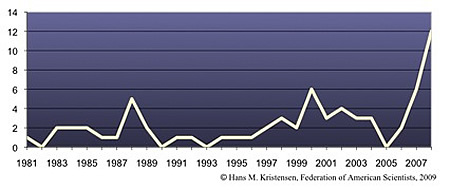
2005: 0 patrols
2006: 2 patrols
2007: 7 patrols
2008: 12 Patrols
2009: 12~ Patrols
It's also not clear what constitutes a "patrol". Does sailing up and down the Chinese coast constitute a patrol, or is deploying into deeper waters several thousand miles off the coast a patrol?
Again, does China even need to send it's SSBNs out on patrol? It seems to me that the PRC leadership is treating them as a rapidly dispersable backup strike system to back up the Second Army Corps (SAC!) land based missiles.In addition, Kristensen said there is no record of a Chinese ballistic-missile sub going out on patrol. "You learn how to use your systems on patrol," he said. "If you don't patrol, how can you fight?"
You forgot their ABM tests. They've been doing a continuing series of ABM tests using KT-xx missiles, which are....modified DF-21s.Anti-ship capabilities
China's missile technology has always been the pointy edge of its spear, ever since Qian Xuesen, the gifted rocket scientist who was kicked out of the United States during the McCarthy period in the 1950s, returned to China.
U.S. government scientists have been impressed by China's capabilities. On Jan. 11, 2007, a Chinese missile traveling at more than four miles a second hit a satellite that was basically a box with three-foot sides, one U.S. government weapons expert said. Over the past several years, China has put into orbit 11 of what are believed to be its first military-only satellites, called Yaogan, which could provide China with the ability to track targets for its rockets. China is also trying to fashion an anti-ship ballistic missile by taking a short-range rocket, the DF-21, and turning it into what could become an aircraft-carrier killing weapon.
Given that the Chinese have about a hundred DF-21s deployed, they could instantly deploy a thin shield of ABM weapons once the C3I network for it is in place
Or it could be that this is a continuing development of a 'universal' missile, the DF-21 and seeing what exactly it can do with the capabilities it gives the PLA(N), from ASAT to ABM to whether it can be used as a 'brilliant' homing ballistic missile.Even though it has yet to be deployed, the system has already sparked changes in the United States. In September, Defense Secretary Robert M. Gates said China's "investments in anti-ship weaponry and ballistic missiles could threaten America's primary way to project power and help allies in the Pacific - particularly our forward bases and carrier strike groups." The U.S. Navy in 2008 cut the DDG-1000 destroyer program from eight ships to three because the vessels lack a missile-defense capability.
But the challenge for China is that an anti-ship ballistic missile is extremely hard to make. The Russians worked on one for decades and failed. The United States never tried, preferring to rely on cruise missiles and attack submarines to do the job of threatening an opposing navy.
U.S. satellites would detect an ASBM as soon as it was launched, providing a carrier enough warning to move several miles before the missile could reach its target. To hit a moving carrier, a U.S. government weapons specialist said, China's targeting systems would have to be "better than world-class."
Wu Riqiang, who worked for six years at the China Aerospace Science and Industry Corporation as a missile designer, said that while he could not confirm that such a missile existed, he believed weapons such as these were essentially "political chips," the mere mention of which had already achieved the goal of making U.S. warships think twice about operating near China's shores.
"It's an open question how these missiles will do in a conflict situation," said Wu, who is now studying in the United States. "But the threat - that's what's most important about them."
In fact, I suspect the carrier mission is actually a smokescreen to test guidance and sensor technologies for a 'smart' DF-21 to give the PLA(N) capabilities similar to Pershing II in striking small point targets like aircraft parked along runways at airbases...
China was always chronically short of helicopters -- this is not limited to the PLA(N); the PLA showed a lot of weaknesses the last few years of disasters due to it's limited helicopter force. Also, the US refused to supply China with parts for some of their american made S-70s -- that has got to have annoyed them.Morale trouble
The deployment of a naval task force to the Gulf of Aden last year as part of the international operation against pirates was seen as a huge step forward for China. The implication was that China's military doctrine had shifted from defending China's borders to protecting China's interests, which span the globe. But the expeditionary force has also provided a window into weaknesses of the People's Liberation Army, according to a new report by Christopher Yung, a former Pentagon official now at the National Defense University.
China's lack of foreign military bases - it has insisted that it won't station troops abroad - limits its capacity to maintain its ships on long-term missions. A shortage of helicopters - the workhorses of a naval expeditionary force - makes it hard for the ships to operate with one another.
But lately, a lot of long range programmes are coming to fruition, like their Z-10 Attack helicopter program, which is slowly entering service, giving them something similar to EuroCopter Tiger.
Likewise, the Z-9 Programme has been shifting into a higher gear from 2000-2010, with more and more indigenous content (it's a clone of the AS-365N Dauphin II); with an increasing amount of aircraft being delivered; including navalized Z-9s.
Two of them are Qiandaohu (FUCHI) class replenishment ships carrying 10,500 tonnes of fuel, 250 tonnes of water and 680 tonnes of ammunition on a total displacement of 23,000 tonnes. One is a ex Soviet AOR Vladimir Peregudov that was being built in the Ukraine in 1991. It was bought in 1996 and finished by the PRC. It can deploy 9,630 tonnes of fuel on a displacement of 37,000 tonnes.China's tiny fleet of replenishment ships - it has only three - doesn't give it enough capacity to do more than one such operation at a time.
Undoubtedly we will see more Qiandaohus built in the 2010-2020 timeframe; increasing the PLA(N)'s global reach as they assimilate the lessons of the first two ships.
There's also the Type 920 Hospital Ship introduced in 2008 for more global outreach and undoubtly for supporting long deployments.
So? Until now all of their deployments have essentially been close to China; fresh water wasn't that much of a problem, nor was food. But now that they're operating longer distances from home; it's highlighting the weaknesses in their stores system; and pointing out the need for more potable and perishable stores.China's navy, according to Yung, also has difficulty maintaining a fresh water supply for its sailors. And poor refrigeration on its ships makes it hard to preserve fruit and vegetables, something that makes for griping on board.
"The sailors during the first deployment had a real morale problem," Yung said, adding that following their mission, they were taken on a beach vacation "to get morale back up."
So why are the J-11Bs being produced with WS-10As if that's such a problem?Empowering local commanders, considered key to a successful fighting force, is something that Beijing clearly has yet to embrace. British Royal Navy Commodore Tim Lowe, who commanded the Gulf of Aden operation for the U.S. 5th Fleet up until May, noted that while other navies would send operations officers to multinational meetings to discuss how to fight pirates, China would dispatch a political officer who often lacked expertise. The concept of sharing intelligence among partner countries was also tough for the Chinese to fathom. To the Chinese, he said, "that was an unusual point."
Tension with the Kremlin
China's military relations with Russia reveal further weaknesses. Between 1992 and 2006, the total value of Russia's arms exports to China was $26 billion - almost half of all the weapons Russia sold abroad.
But tensions arose in 2004 over two issues, Russian experts said. Russia was outraged when it discovered that China, which had licensed to produce the Su-27 fighter jet from Russian kits, had actually copied the plane. China was furious that after it signed a contract for a batch of IL-76 military transport planes it discovered that Russia had no way to make them. After receiving 105 out of a contracted 200 Su-27s, China canceled the deal and weapons negotiations were not held for several years.
Purchases of some items continued - S-300 air defense systems and billions of dollars worth of jet engines. An engine China made for its Su-27 knock-off would routinely conk out after 30 hours whereas the Russian engines would need refurbishing after 400, Russian and Chinese experts said.
HAHAHAHHAHAHAHAHAHAHAH"Engine systems are the heart disease of our whole military industry," a Chinese defense publication quoted Wang Tianmin, a military engine designer, as saying in its March issue. "From aircraft production to shipbuilding and the armored vehicles industry, there are no exceptions."
When weapons talks resumed with Russia in 2008, China found the Russians were driving a harder bargain. For one, it wasn't offering to let China produce Russian fighters in China. And in November, the Russians said they would only provide the Su-35 for China's aircraft carrier program if China bought 48 - enough to ensure Russian firms a handsome profit before China's engineers attempted to copy the technology.
You silly Russians. The Chinese already have the J-15, which started with the T-10K-3 prototype that they bought from the Ukraine in 2001. So why should they buy the Su-35?
Oh, and the first J-15 prototype flew with WS-10As. I thought engines were a problem?
Heef.Russia also announced that the Russian military would buy the S-400 air defense system first and that China could get in line.
"We, too, have learned a few things," said Vladimir Portyakov, a former Russian diplomat twice posted to Beijing.



